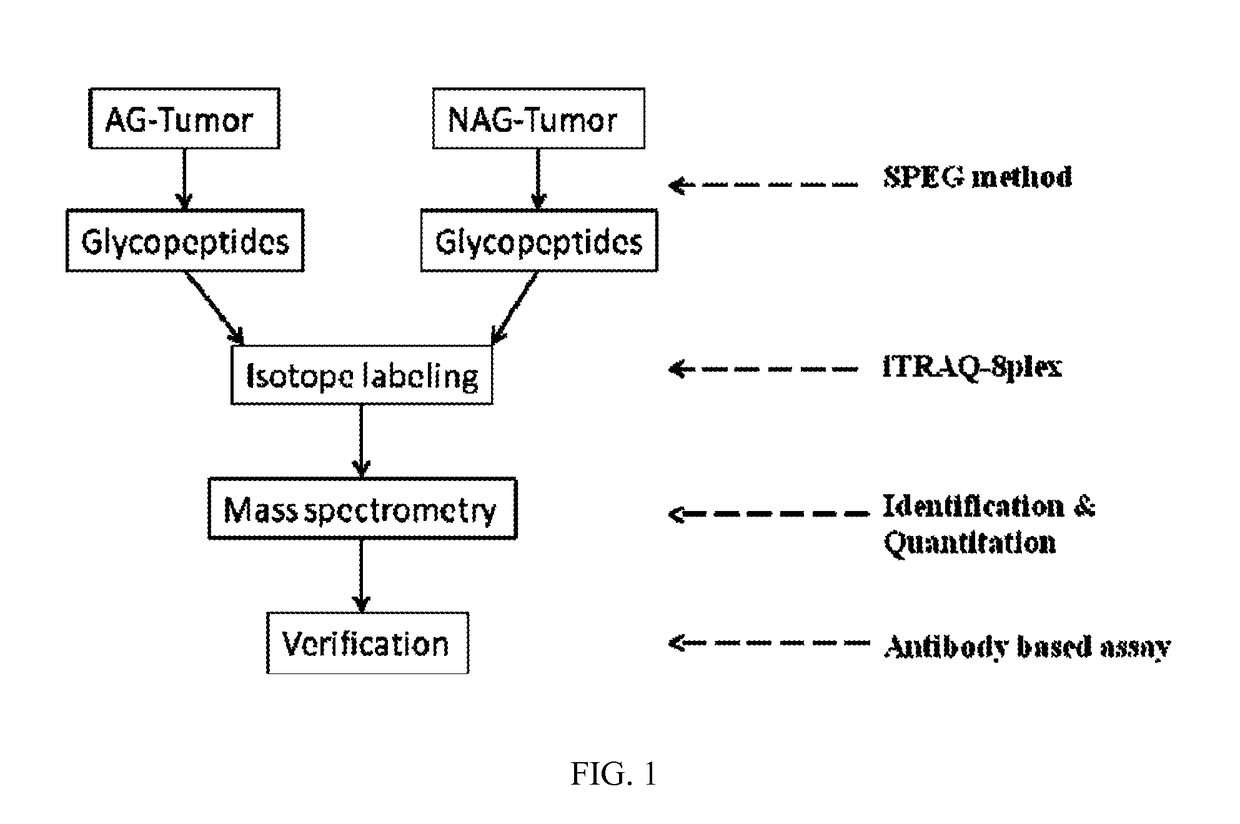Biomarkers for aggressive prostate cancer
a prostate cancer and biomarker technology, applied in the field of biomarkers, can solve the problems of high metastasis rate, requiring early detection and treatment, and low specificity of psa, and achieve the effect of facilitating the use of oct-embedded frozen tissues
- Summary
- Abstract
- Description
- Claims
- Application Information
AI Technical Summary
Benefits of technology
Problems solved by technology
Method used
Image
Examples
example 1
Quantitative Glycoproteomic Profiling of Aggressive (AG) Prostate Tumors and Nonaggressive (NAG) Prostate Tumors
[0123]The scheme of the present study is shown in FIG. 1. Briefly, to identify glycoproteins associated with AG-prostate cancer, glycoproteins from OCT-embedded AG-prostate tumor and NAG-prostate tumor tissues were quantitatively analyzed. The candidate proteins were further verified using Western blot and immunohistochemistry.
[0124]Glycopeptides were isolated from four AG-prostate tumors and four NAG-prostate tumors using solid-phase extraction of glycopeptides (SPEG). To determine the relative abundance of glycoproteins in AG and NAG-prostate cancer tissues, the glycopeptides isolated from each specimen were labeled with iTRAQ prior to LC-MS / MS analysis. From mass spectrometry analysis of glycopeptides, 102 unique N-linked glycopeptides were identified with 95% confidence, representing 79 unique glycoproteins (FIG. 7).
example 2
Glycoprotein Changes Associated with Aggressive Prostate Tumors
[0125]To identify the glycoproteins associated with aggressive prostate tumors, the relative abundance of each glycopeptide in tissues of four cases of AG prostate cancer and four cases of NAG-prostate cancer were determined by iTRAQ labeling and tandem mass spectrometry (FIG. 7). With the use of the peak intensity of the iTRAQ reporter tags which represented the relative abundance of the peptides, t tests were performed to identify the glycopeptides and the glycoproteins associated with AG-prostate tumors. According to iTRAQ results, glycopeptides from three glycoproteins, microfibrillar-associated protein 4, periostin, and cathepsin L, showed a significant difference between the AG-prostate cancer group (iTRAQ Tag 113, 114, 115, and 121) and the NAG-prostate cancer group (iTRAQ Tag 116, 117, 118, and 119) (with p-values of less than 0.05) (FIGS. 2, 5, 7 and 8). Two peptides, vDLEDFEnNTAYAk and fnGSVSFFR (lower case v, ...
example 3
Verification of Glycoproteomic Results Using Western Blot
[0126]To verify the proteomic results, the four cases of AG-prostate tumors and four cases of NAG-prostate tumors were analyzed by Western blot assay. Periostin showed overexpression in all four AG-prostate tumors, while cathepsin L was elevated in three out of four AG-prostate tumors, compared to the NAG-prostate tumors (FIG. 3). A specific band for microfibrillar-associated protein 4 could not be identified by Western blot to verify its expression. IgG was detected evenly in each sample and was used as a quantitation control. These observations supported the glycoproteomic results for periostin and cathepsin L.
PUM
| Property | Measurement | Unit |
|---|---|---|
| temperature | aaaaa | aaaaa |
| pH | aaaaa | aaaaa |
| voltage | aaaaa | aaaaa |
Abstract
Description
Claims
Application Information
 Login to View More
Login to View More - R&D
- Intellectual Property
- Life Sciences
- Materials
- Tech Scout
- Unparalleled Data Quality
- Higher Quality Content
- 60% Fewer Hallucinations
Browse by: Latest US Patents, China's latest patents, Technical Efficacy Thesaurus, Application Domain, Technology Topic, Popular Technical Reports.
© 2025 PatSnap. All rights reserved.Legal|Privacy policy|Modern Slavery Act Transparency Statement|Sitemap|About US| Contact US: help@patsnap.com



